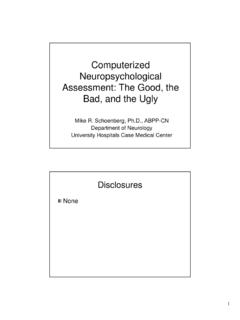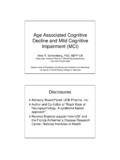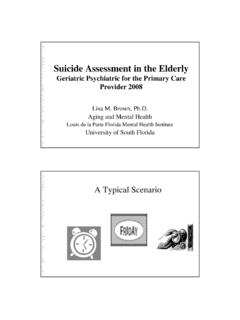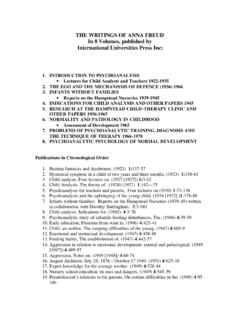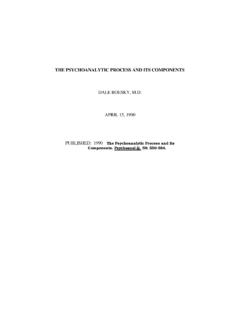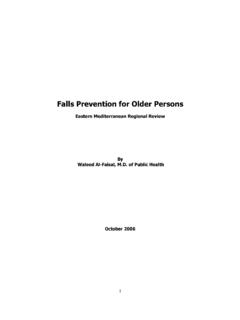Transcription of Managing Insomnia and Anxiety In the Elderly
1 1 Managing Insomnia and Anxiety In the ElderlyFrancisco Fernandez, and ChairUSF Health Department of Psychiatry Insomnia - Objectives To review the new research findings of Insomnia in the Elderly To discuss the implications for improving clinical practice2 Barriers & Changes In AttitudeInsomnia is associated with significant impairment in function and quality of lifeChronic Insomnia occurs in the context of med-psych disordersOtherTreat Insomnia as well as other disorder(s): improvements in Insomnia may result in improvements in other disorder(s)Hypnotics should generally be used only for short-term treatmentChronic Insomnia exists and merits treatmentTreat the primary disorderTreatmentInsomnia is a disorder, typically comorbid with other disordersInsomnia is a symptom, not a primary disorderDefinitionNIH 2005 NIH 1983 Myth 1: Insomnia is Sleep Deprivation Sleep deprivation Adequate ability to sleep Inadequate opportunity Insomnia patients Inadequate ability to sleep Adequate opportunity3 Myth 2: Insomnia Symptom Unique set of physiologic changes Associated with impairment in function and quality of lifeInsomnia Is Associated With Decreased Cortical Activity Thomas M et al.
2 J Sleep Res. 2000;9 PET Study of Healthy, Sleep-Deprived Adults, Showing Decreased Metabolism in the Thalamus, Prefrontal Cortex, and Inferior Parietal CortexFDG, fluorodeoxyglucose; PET, positron emission tomographyPrefrontalcortexInferior parietalcortexOccipitalcortexThalamus4 Insomnia Definition(Research Diagnostic Criteria)A. The individual reports one or more of the following sleep-related complaints:1. Difficulty initiating sleep2. Difficulty maintaining sleep3. Waking up too early, or 4. Sleep that is chronically nonrestorative or poor in qualityB. The above sleep difficulty occurs despite adequate opportunity and circumstances for sleepEdinger JD et al. Sleep. 2004;27 At least one of the following forms of daytime impairment related to the nighttime sleep difficulty is reported by the individual:1. Fatigue/malaise2. Attention, concentration, or memory impairment3. Social/vocational dysfunction or poor school performance4.
3 Mood disturbance/irritability5. Daytime sleepiness6. Motivation/energy/initiative reduction7. Proneness for errors/accident at work or while driving8. Tension headaches, and/or GI symptoms in response to sleep loss9. Concerns or worries about sleepEdinger JD et al. Sleep. 2004;27 Definition(Research Diagnostic Criteria)5 Foley DJ et al. Sleep. 1995;18 Complaints Prevalence within Elderly (n=9,282)NIA Multicenter Study Interview Data0%10%20%30%40%Symptoms Suggesting ChronicInsomniaNo Sleep Complaints2912 More prevalent among those with depressed mood, respiratory symptoms, fair to poor health, physical disabilityFunctional Impairment and Health Services Cost for Elderly Patients with and without InsomniaSimon GE, VonKorff M. Am J ;154 Insomnia (Self Rating)(Interview Rating)(3 Months)(6 Months)01234 Social DisabilityScheduleRole of LimitedActivityTotal HealthcareCosts ($ 000s). 3: Hypnotic Use is Responsible for Falls in the Elderly The relationship between Insomnia , hypnotic use, falls, and hip fractures was examined in older people 34,163 nursing home residents (76% women), aged 65 and older and with 150-210 days follow-up Results Insomnia is associated with increased risk of future falls Hypnotic use was not independently associated with falls Conclusion In Elderly nursing home residents, Insomnia , but not hypnotic use, is associated with a greater risk of subsequent fallsAvidan AY et al.
4 J Am Geriatr Soc. 2005;53 vs Comorbid InsomniaOhayon MM. Sleep Med Rev. 2002;6 Disorders44%Primary Insomnia16%Other Illnesses, Medications, etc11%Other Sleep Disorders5%No DSM-IV Diagnosis24%7 Medical Disorders Comorbid with Insomnia Arthritis and other chronic pain syndromes Congestive heart failure Cerebrovascular disease Chronic pulmonary disease Renal failure Parkinson s disease Dementia Gastroesophageal refluxThink about pain, breathing difficulty, and impaired mobilityMedications and Substances Associated with Insomnia Alcohol Acute use Withdrawal Caffeine Nicotine Antidepressants SSRI SNRI, atypical Corticosteroids Decongestants Phenylpropanolamine Pseudoephedrine agonists, theophylline derivatives antagonists Statins Stimulants Dopamine agonistsAny drug that crosses the blood brain barrier and affects a neurotransmitter system may be associated with insomniaSSRI = Selective Serotonin Reuptake = Serotonin and Norepinephrine Reuptake.
5 Cognitive and behavioral therapies Pharmacologic therapies Future directionsBarriers to Use of Behavioral Insomnia Therapies Lack of awareness Limited number of Providers with expertise Time requirements Misconceptions about patient acceptance Restricted insurance reimbursement9 Unrealistic sleepexpectations Misconceptions about sleep Sleep anticipatoryanxiety Poor coping skills Excessive time in bed Irregular sleepschedules Sleep incompatible activities Hyperarousal Inadequate sleephygienePsychologic/Behavioral Treatments (Treatment Targets)CognitiveCognitive TherapyBehavioralSleep RestrictionStimulus ControlRelaxationEducationalSleep HygieneEducationSleep Hygiene Education Caffeine: sources and effects Nicotine Role of exercise Light bedtime snack (milk, peanut butter) Alcohol, tobacco, and other substances Environment: light, noise, temperature10 Sleep Restriction Therapy Rules Cut bedtime to actual amount patient reports sleeping, but not <4 hours/night Prohibit sleep outside of these hours Have patient report daily the amount of sleep obtained Compute sleep efficiency (SE); based on moving average of 5 nights, when SE is >85%, increase bedtime by 15 minutes With the Elderly , SE cutoff is 80%.
6 Allow a 30-minute napSpielman AJ et al. Sleep. 1987;10 Control Therapy Rules Go to bed only when sleepy Use the bed only for sleeping do not read, watch TV, or eat in bed If unable to sleep, move to another room. Stay up until really sleepy. The goal is to associate the bed with falling asleep quickly Repeat tactic immediately above as often as necessary Awaken at the same time every morning regardless of total sleep time Do not napBootzin RR, Epstein DR. Stimulus Control. In: Lichstein KL, Morin CM, eds. Treatment of late-life Insomnia . Thousand Oaks, Calif: Sage; 2000 Quiet self-inquiry Relaxation response (Benson, 1975) Quiet environment Object to dwell upon (monotonous stimulation) Passive attitude Comfortable positionLichstein KL et al. Therapy Identify dysfunctional attitudes and beliefs about sleep Explore the validity of self-statements about sleep Replace dysfunctional attitudes and beliefs about sleep with more appropriate self-statements Worry time Remove thoughts and general cognitive activation away from bedtime and moves them to a better period of the day Write down thoughts (brainstorm) Order priorities for attention Develop problem-solving strategies Regular practice is important (be proactive)12 Cognitive Behavioral Therapy vs RelaxationTherapy for Primary Sleep-maintenance InsomniaCBT = Cognitive Behavioral = Progressive Muscle = Placebo = Total Sleep = Middle Wake Time After Sleep JD et al.
7 JAMA. 2001;285 <.002; CBT>PMR and PTMean Sleep Efficiency(%)01020304050 CBTPMRPTP=.004; CBT<PMR and PTMean ; CBT>PTMean TSTH oursFDA Public Health AdvisoryMarch 22, 2004 Subject: WORSENING DEPRESSION AND SUICIDALITY IN PATIENTS BEING TREATED WITH ANTIDEPRESSANT MEDICATIONST oday the Food and Drug Administration (FDA) asked manufacturers of the following antidepressant drugs to include in their labeling a Warning statement that recommends close observation of adult and pediatric patients treated with these agents for the emergence of agitation, irritability, Insomnia , and other symptoms inclusive of worsening depression or the emergence of suicidality. The drugs that are the focus of this new Warning are: Fluoxetine (Prozac); Sertraline (Zoloft); Paroxetine (Paxil); Fluvoxamine (Luvox); Citalopram (Celexa); Escitalopram (Lexapro); Bupropion (Wellbutrin); Venlafaxine (Effexor); Nefazodone (Serzone); and Mirtazapine (Remeron).13 New Advisory Oct 9th on Coumadin Food and Drug Administration (FDA) requested that Bristol-Myers Squibb strengthen its US label for warfarin (Coumadin) to include a black-box warning about the risk for major or fatal bleeding.
8 The new black box notes that warfarin can cause major or fatal bleeding. Bleeding is more likely to occur during the starting period and with a higher dose (resulting in a higher INR). Risk factors for bleeding are listed as: high intensity of anticoagulation (INR greater than ), age 65 or over, highly variable INRs, history of gastrointestinal bleeding, hypertension, cerebrovascular disease, serious heart disease, anemia, malignancy, trauma, renal insufficiency, concomitant drugs, and long duration of warfarin therapy. Regular monitoring of INR should be performed on all treated patients. The FDA Medwatch announcement also notes that warfarinprescriptions will also be issued with a new patient medication guide warning about potentially serious bleeding with the off The MEDWATCH Press .. O2 Food and Drug Administration (FDA) requested that nature include a black-box warning about the risk of oxygen used for respiration. The new black box notes that oxygen can cause major or fatal problems in humans.
9 While atmospheric oxygen and other gases are generally non-toxic, they can have a hazardous effect on your health. This is more likely to occur if oxygen is enriched in your environment. Risk factors include being a breathing human being with normal senses which generally can t detect changes in atmospheric concentrations. Apart from the hazards of oxygen enrichment of the air already described, the following misuses of oxygen are particularly dangerous and must be strictly forbidden: Inflating vehicle tires, rubber boats etc. Cooling or freshening the air in confined spaces. Cooling the person. Dusting benches, machinery and clothing. This list is by no means for TodayNo Clinician Left JK. Sleep. 2004;27 Most Commonly Used for Insomnia in 2002 Occurrences (Millions)15 Pharmacologic Treatments FDA-approved drugs Benzodiazepine receptor agonists Melatonin receptor agonist Drugs used off-label (not FDA approved for Insomnia ) Sedating antidepressants Antipsychotics Self medication Alcohol H1 antihistamines (OTC sleep aids) Herbal remediesDrugs Indicated for Insomnia * Modified *Ambien CRZolpidem Ext.
10 ClassDose (mg)T1/2(Hours)BrandGeneric16 Sleep Onset (LPS)0102030405060 Baseline12345 PlaceboZaleplon 10 mg* P<.031 or better vs JK et al. Sleep Med. 2000;1:41-49.**MinutesWeekSleep Maintenance (WASO) Decrease in wake time after sleep onset (adults with primary Insomnia ) Cumulative analysis of WASO from hour 1 through hour 6 postdoseRoth T et al. Sleep Med. 2006;7 Ext. Rel. mgMinutes*P<.0001**(N=212)(N=199)17 Adverse EventsBzRA & Other Hypnotic Agents Determinants Cmax, T1/2 AEs Somnolence Dizziness Ataxia Taste Amnesia Nausea Discontinuation effects Rebound Insomnia , withdrawal syndrome Dependence liability Dose escalation, self-administration outside therapeutic contextBzRA = Benzodiazepine Receptor Discontinuation Effects Recurrence Return of original symptom(s) At basal level of severity Rebound Insomnia Single symptom Exacerbation relative to baseline 1 to 2 night duration Withdrawal syndrome Complex of symptoms Longer durationBzRA = Benzodiazepine Receptor Insomnia and Withdrawal Epidemiologic data 4% to 9% of patients treated chronically with hypnotics in clinical practice experience rebound Insomnia This was no more common with prescription hypnotics than OTC medsOTC = MB, Uhlenhuth EH.
